
Main content:
- What is a ternary lithium battery?
- What are the types and characteristics of ternary materials?
- What are the advantages and disadvantages of ternary lithium batteries?
- How do you charge your ternary lithium battery?
- How long does it takes go charge a ternary lithium battery?
- What is the temperature performance of the ternary lithium battery?
- Are ternary lithium batteries safe?
- What precautions should be taken while using ternary lithium batteries?
- Comparison of Ternary Lithium batteries and Lithium iron phosphate(LiFePO4) batteries
- Which is better LiFePO4 or ternary lithium batteries?
- What is the latest development of the ternary lithium battery technology?
1.What is a ternary lithium battery?
A ternary lithium battery refers to a kind of lithium battery in which the cathode material is nickel salt, cobalt salt, manganese salt/lithium aluminate, the anode material is graphite, and the electrolyte is mainly lithium salt such as lithium hexafluorophosphate. The three elements of the cathode materials are also known as ternary materials, these elements are mixed with each other in definite proportions. Each element plays a vital role in battery's performance and give it specific properties. Ternary lithium batteries have been widely used in consumer digital electronic products, industrial equipment, medical equipment and other small and medium-sized lithium battery fields.

2.What are the types and characteristics of ternary materials?
① Types of ternary materials
The ternary materials refer to a cathode material composed of three elements of nickel, cobalt, manganese or nickel, cobalt and aluminum, namely nickel cobalt lithium manganate (NCM) or nickel cobalt lithium aluminate (NCA). According to the different contents of nickel, cobalt and manganese in ternary materials, NCM materials can be divided into NCM523, NCM622, NCM811, etc. NCM523 refers to the chemical composition of ternary materials is Li (Ni0.5Co0.2Mn0.3) O2. In the NCA material, manganese is replaced by aluminum. Considering factors such as technological progress and process manufacturing, NCM523 is currently the most widely used ternary material.
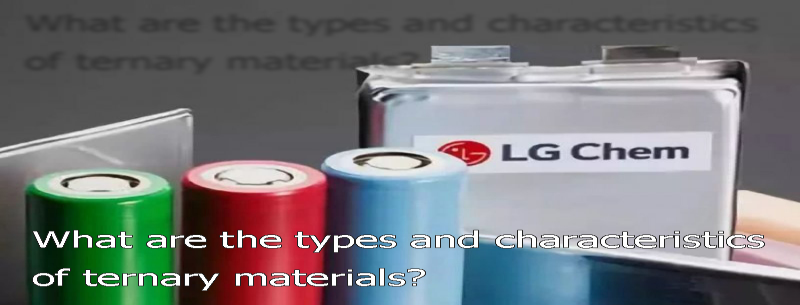
② Characteristics of ternary materials
The technical advantage of ternary materials lies in the combination of the advantages of LiCoO2, LiNiO2, LiMnO2 or LiAlO2, so that Ni, Co, Mn or Al can play a synergistic effect. Among them, the main role of Ni is to increase the energy density, the main role of Co is to stabilize the layered structure of the ternary material, the electronic conductivity and the cycle performance of the material are improved, and the main role of Mn is to reduce the cost and improve the structural stability and safety of the material.
Different element ratios can obtain different electrode properties. There are the distinct characteristics of ternary materials, such as they have more tensile strength than other materials and have more toughness and rigidity than typical metals. They are corrosion-resistant, which means they do not corrode easily like typical metals and have high durability compared to typical metals. In addition, the ternary material have more ductility compared to typical metals.
3.What are the advantages and disadvantages of ternary lithium batteries?
① Advantages of ternary lithium battery
There are many benefits of ternary lithium batteries due to which they are used in wide range of applications. Some of the benefits are discussed below.
High energy density
Since the cathode material of the ternary lithium-ion battery uses the nickel cobalt lithium manganate ternary cathode material, this material combines the advantages of the three materials of lithium cobalt oxide, lithium nickel oxide and lithium manganate, forming a three-phase eutectic system of three materials. The comprehensive performance of this ternary synergistic effect is superior to that of any single combination compound, enabling the ternary lithium battery is superior in energy density. This means it can store a huge amount of energy in a small unit volume.
High charging efficiency
The constant current of the ternary lithium battery is relatively high. The constant current ratio (that is, the ratio of the constant current charging power to the total battery capacity) is an important data to measure the battery charging efficiency. The higher the constant current ratio, the better the battery charging performance.
Low temperature resistance
Ternary lithium battery has an advantage in low temperature resistance, it has good stability in low temperature environment, and can still maintain about 70%~80% of the normal battery capacity at -20℃.
Long cycle life
As a kind of lithium-ion battery, the battery life of ternary lithium battery will undoubtedly be longer than that of lead-acid batteries and other batteries. But this battery have a short life and does not last long compared to some other lithium batteries, the most typical is the lithium iron phosphate battery. The complete charge-discharge cycle times of a lithium iron phosphate battery can reach 4,000, while a ternary lithium battery will begin to experience battery capacity decay when the complete charge-discharge cycle is greater than 1500 times.
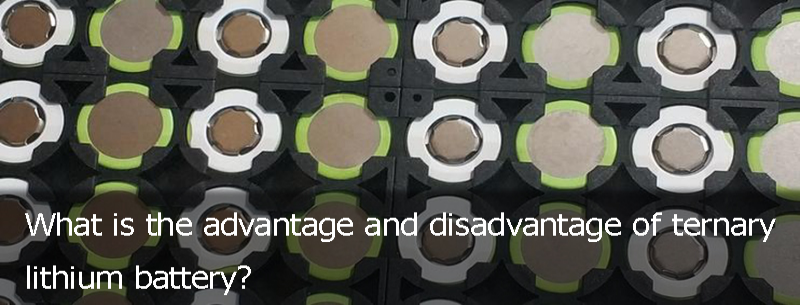
② Disadvantages of ternary lithium battery
There are following drawbacks of ternary lithium battery.
Material cost
Since the ternary cathode material required by the ternary lithium battery is relatively expensive, the cost price of the ternary lithium battery is also relatively high. For example, the cost price of nickel-cobalt-aluminum ternary lithium-ion batteries is as high as $600-1000/KWh.
Thermal instability
The other major drawback of using ternary lithium battery is that its performance is affected by temperature changes. It can not withstand high temperatures and shows decomposition. The cathode material of terpolymer lithium battery has poor thermal stability. It will decompose and release oxygen at around 300 ° C. Once thermal runaway occurs, there is a high risk of fire.
Less safety
The molecular structure of the ternary lithium battery material is a relatively active layered oxide, which may ignite rapidly under impact and high temperature, making the ternary lithium battery is not safe to use compared to some other lithium batteries. Therefore the protection of the ternary battery should be improved to prevent the decomposition of the battery at high temperatures.
4.How do you charge your ternary lithium battery?
The ternary lithium-ion battery must use a special charger for lithium ion battery, otherwise it may affect its performance. Do not specifically discharge the lithium-ion battery before charging since it has no memory effect. When charging, try to use slow charging and reduce fast charging. After charging, it should be prevented from being placed on the charger to avoid overcharge, and the battery should be separated from the mobile electronic product when it is not used for a long time.

We charge a ternary lithium battery by a process which is called cc-cv(constant voltage constant current). In first step the current is set constant by charger until the voltage of the battery comes to the previously set certain voltage. Then starts the secondary step of the charging where the current level is set at certain level instead of the voltage. The current rises gradually, when the voltage reaches to maximum, it is kept by charger and eventually current becomes low.
5.How long does it takes go charge a ternary lithium battery?
The charging rate of the ternary lithium battery depends upon the fact that which type if charger is being used. The ternary lithium battery have the capacity to withdraw all of the current that is produced during the current charge round. For example if you have 60 ampere charger and 120 ampere hour ternary lithium battery. To determine the charging rate 120 is divided by 60 which results in a charging time of 2 hours approximately. The speedy charging of ternary lithium battery can potentially decompose it. Therefore fast charging of the battery should be done only in emergency.
6.What is the temperature performance of the ternary lithium battery?
The ternary lithium battery is suitable for a wide range of operating temperatures, within the range of -20~60℃. In general, increasing the temperature can improve the kinetic conditions within the ternary lithium battery, thereby improving the performance of the battery, but the high temperature can negatively affect the stability of the material, resulting in a decrease in the material cycle performance.
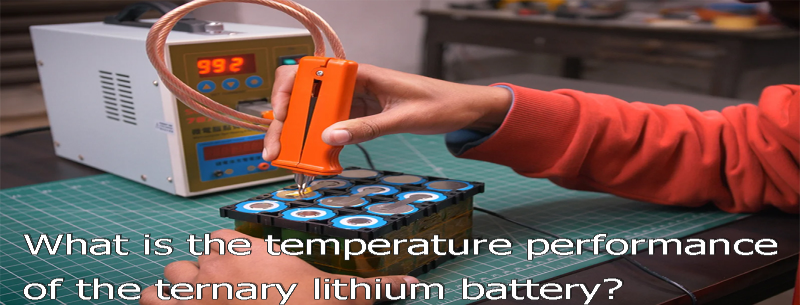
After increasing the temperature to 60 °C, the capacity retention rate of the ternary lithium battery will drop significantly. In addition, although the ternary lithium battery has stable performance at low temperature, if it is lower than its normal operating temperature range, it will cause irreversible damage to the battery.This means a specific temperature environment is required for the ternary lithium battery to work properly.
7.Are ternary lithium batteries safe?
Ternary lithium batteries can be safe to use thanks to the existence of BMS, which serves as an important protective element that protects batteries from damage caused by overcharge, overdischarge and extreme temperatures and other factors, helping to improve battery safety, performance, and lifespan. In addition, avoid high temperature working environment when using ternary lithium battery.
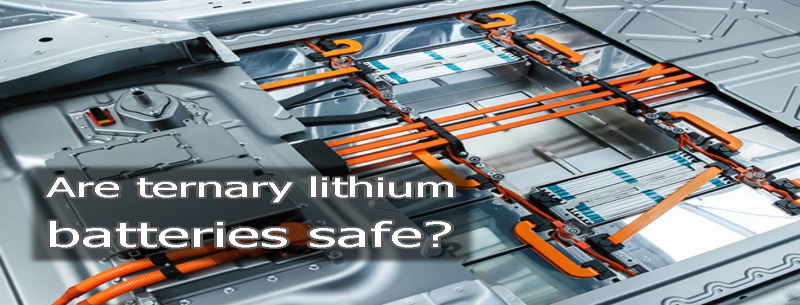
8.What precautions should be taken while using ternary lithium batteries?
Following precautions should be taken while using ternary lithium batteries. Avoid overcharging and overdischarging, which can adversely affect battery performance. The ternary lithium battery can be idle for a long time, but it must be in a cool and dry environment, and it needs to maintain 40-60% electricity and regularly charge and discharge it. Try to store the ternary lithium batteries at a moderate temperature range. So by taking some of these precautionary measures the performance and shelf life of ternary lithium batteries can be improved.
9.Comparison of Ternary Lithium batteries and Lithium iron phosphate(LiFePO4) batteries
The lithium iron phosphate battery refers to a lithium ion battery that uses lithium iron phosphate as a cathode material. Both these batteries have a wide range of applications. Here is the comparison of these two battery types.
① Voltage
When we compare the voltage of the LiFePo4 battery and ternary lithium battery we find out that the voltage of ternary lithium battery is slightly higher than that of LiFePO4 battery. The cell voltage of the lithium iron phosphate battery is usually 3.2V, while the nominal voltage of the ternary lithium battery is generally 3.7/3.6/3.65v.
② Specific energy
When we look at the specific energy of lithium iron phosphate battery and ternary lithium battery we find that the specific energy of lithium iron phosphate battery is less than the ternary lithium battery.
③ Energy density
In terms of energy density, ternary lithium batteries are superior than lithium iron phosphate batteries, , which means that the ternary battery can store more energy in unit volume. In fact, the energy density of lithium iron phosphate batteries has far exceeded that of other types of batteries such as lead-acid batteries.
④ Safety
When we focus on the safety performance of ternary lithium batteries and lithium iron phosphate batteries we conclude that lithium iron phosphate batteries are superior in terms of safety. When we look at the structure of LiFePO4 we find that they have a strong bond between phosphorous and oxygen.
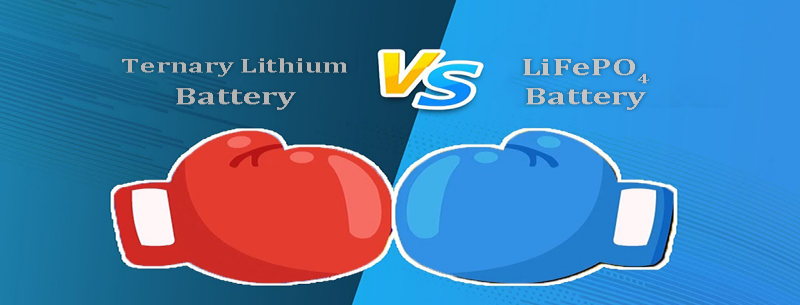
This bond is strong enough to withstand the elevated temperature without being decomposed. So at high temperature it will not show explosion or degradation. This battery has no safety issues. But as discussed earlier ternary batteries do not perform as well in terms of safety as lifepo4 battery. Because these batteries may have the risk of explosion and degradation at elevated temperature.
⑤ Life cycle
When we look at the life cycle of lithium iron phosphate batteries and ternary lithium batteries we conclude that LiFePO4 batteries have long life cycle than ternary lithium batteries.
⑥ Cost
Compared with the nickel and cobalt elements necessary for the production of ternary lithium batteries are precious metals, lithium iron phosphate batteries do not contain precious metal materials. Therefore, in terms of production cost, the battery of lithium iron phosphate material is much lower than the battery of ternary lithium material.
⑦ Applications
Lithium iron phosphate batteries are used in UPS power supply as UPS batteries. In addition, they are also widely used in monitoring devices, electrical vehicles, solar power plants, flashlights, etc. Ternary lithium batteries are used in electrical vehicles, motorcycles, flashlights and other application scenarios with high energy requirements.
10.Which is better LiFePO4 or ternary lithium batteries?
Comprehensive analysis of the characteristics of the two batteries shows that ternary materials have advantages in battery energy density, charge-discharge efficiency, and low temperature resistance, but are weaker than lithium iron phosphate batteries in terms of cost, cyclability, and safety. In comparison, ternary lithium batteries and lithium iron phosphate batteries still have their own pros and cons. But if the bottleneck of energy density is broken, in the near future, lithium iron phosphate battery will be more popular than ternary lithium battery because of its high safety and long cycle life.

11.What is the latest development of the ternary lithium battery technology?
In order to solve the battery degradation problems associated with the structure of anode, cathode, and polymer electrolyte the research is being done to modify the structure of electrodes and to bring advancement in the design of polymer electrolyte. Currently, an innovative battery technology has emerged, that is, a ternary lithium iron battery with a mixed arrangement of ternary lithium and lithium iron phosphate cells, which applies a new generation of CTP (Cell to Pack) technology.